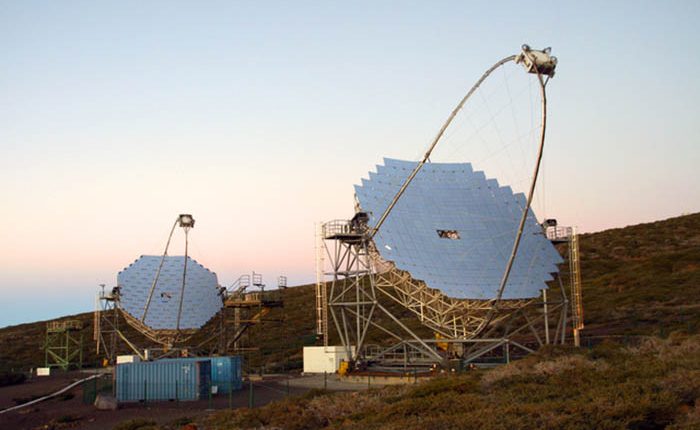Gamma-ray bursts (GRBs) are the most violent explosions in the Universe, suddenly appearing in the sky, about once per day. They are thought to result from the collapse of massive stars or the merging of neutron stars in distant galaxies. The first GRB detected by the MAGIC telescopes, known as GRB 190114C, reveals for the first time the highest-energy photons measured from these objects. This ground-breaking achievement by MAGIC provides critical new insight for understanding the physical processes at work in GRBs, which are still mysterious. On January 14th, 2019, a GRB was discovered independently by two space satellites: the Neil Gehrels Swift Observatory and the Fermi Gamma-ray Space Telescope. The event was named GRB 190114C, and within 22 seconds, its coordinates in the sky were distributed as an electronic alert to astronomers worldwide, including the MAGIC Collaboration, which operates two 17m diameter Cherenkov telescopes located in La Palma, Spain. An automatic system processes in real time the GRB alerts from satellite instruments and makes the MAGIC telescopes point rapidly to the sky position of the GRB in just 50 seconds after the beginning of the GRB.
The analysis of the resulting data for the first tens of seconds reveals emission of photons in the afterglow reaching teraelectronvolt (TeV) energies, that is, a million million (1012) times more energetic than visible light, and still a million times more energetic than the gamma rays through which GRBs are detected in satellite detectors. During this time, the emission of TeV photons from GRB 190114C was 100 times more intense than the brightest known steady source at TeV energies, the Crab Nebula. In this way, GRB 190114C became the record setter as the brightest known source of TeV photons. An extensive campaign of multi-wavelength (MWL) follow-up observations of GRB 190114C ensued by over two dozen observatories and instruments, providing a full observational picture of this GRB from the radio band to TeV energies. In particular, optical observations made a measurement of the distance to GRB 190114C. It was found that this GRB is located in a galaxy from which it took 4.5 billion years for the light to reach the Earth.


“After more than 50 years since GRBs were first discovered, many of their fundamental aspects still remain mysterious”, says Razmik Mirzoyan, the Spokesperson of the MAGIC Collaboration. “The discovery of gamma-ray emission from GRB 190114C in the new, TeV window of the electromagnetic spectrum shows that the GRB explosions are even more powerful than thought before. The wealth of new data on GRB 190114C acquired by MAGIC offer important clues to unravel some of the mysteries concerning the physical processes at work in GRBs”. Two papers in the Nature issue of 21 November describe the detection of the gamma rays up to TeV energies with MAGIC and the indication that inverse Compton scattering is the responsible process at work.
A third paper in the same issue describes the detection of another gamma ray burst with energies above 100 GeV (but below 1 TeV) from GRB 180720B, using the High Energy Stereoscopic System (H.E.S.S.) array of telescopes in Namibia. Although these photons were lower in energy and fewer in number than those observed from GRB 190114C, they were detected from deep in the afterglow phase.
Armenian physicists from the A Alikhanian National Lab participated in both the MAGIC and the H.E.S.S. collaborations. Initially, the technique of arrays of Imaging Atmospheric Cherenkov Telescopes (IACTs) had been pioneered at Mt. Aragats in the 1980s. A setup was planned around a large cosmic ray array, named ANI. However, due to the collapse of the Soviet Union, construction of the array stopped and two leading physicists, Felix Aharonyan and Razmik Mirzoyan, moved from the Yerevan Physics Institute to Germany. With colleagues from the Max Planck Institutes in Munich and Heidelberg,


Armenian physicists launched the first system of European ACTs on La Palma, Canary Islands (HÅGRÀ). The IACT technique, and the Armenian design, proved to be very successful and later larger telescopes were commissioned on La Palma (MAGIC) and in Namibia (H.E.S.S.). Sophisticated methods of gamma image selection based on machine learning algorithms were developed at YerPhI by Ashot Chilingarian and for the first time applied to IACT data analysis. Recently a group of young Armenian astrophysicists from the International Center for Relativistic Astrophysics Network (ICRANet-Armenia) joined the MAGIC project. Currently, an international collaboration pursues the Cherenkov Telescope Array (CTA) project, with about a hundred IACTs, that will greatly surpass the capabilities of the existing telescopes.
Thus, the booming field of high-energy astrophysics, with its steady stream of exciting results, is firmly based on important contributions of Armenian scientists. Three papers in one issue of Nature is an exceptional result, of which the gamma ray community, including Armenia, can be very proud.
For more information please visit https://www.mpi-hd.mpg.de/hfm/HESS/pages/about/ .










